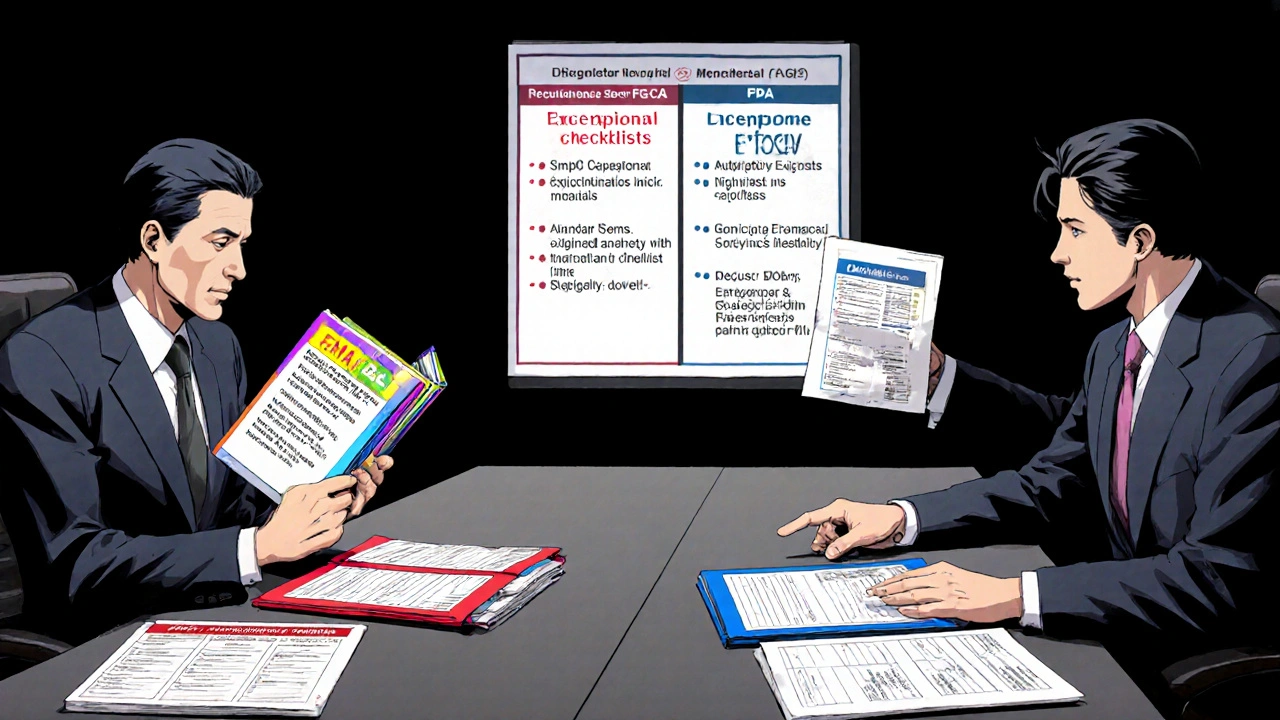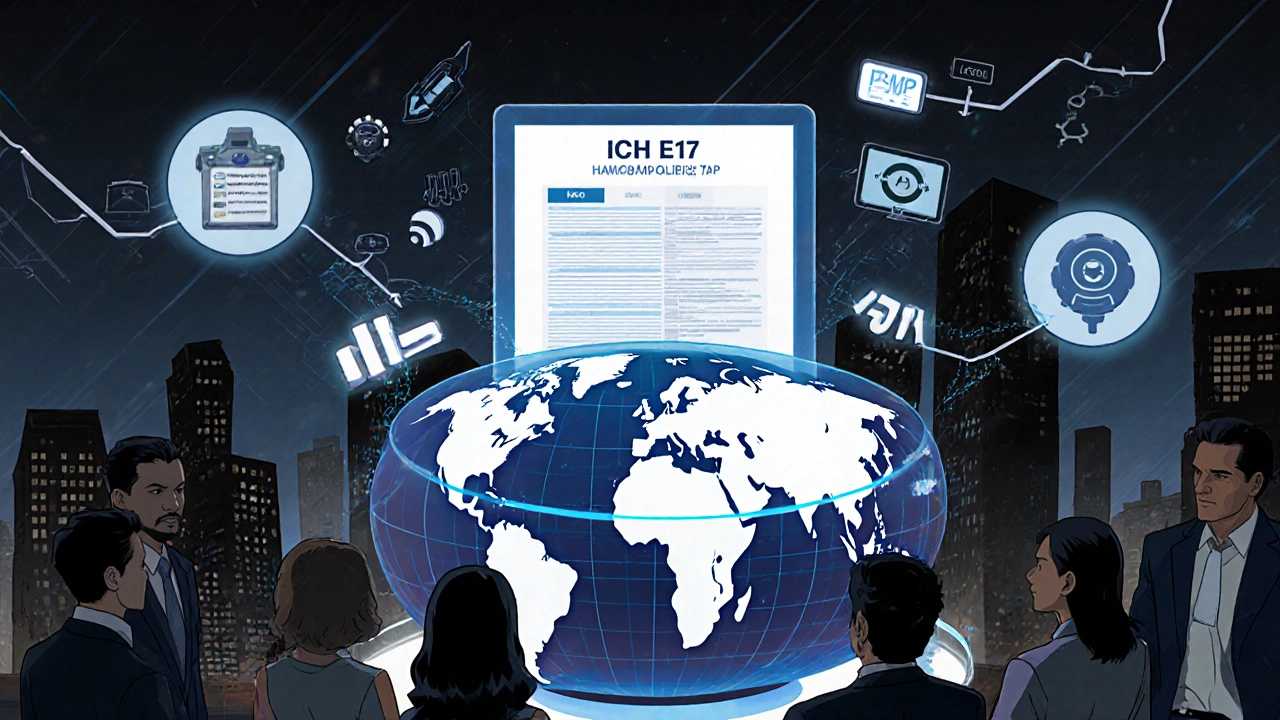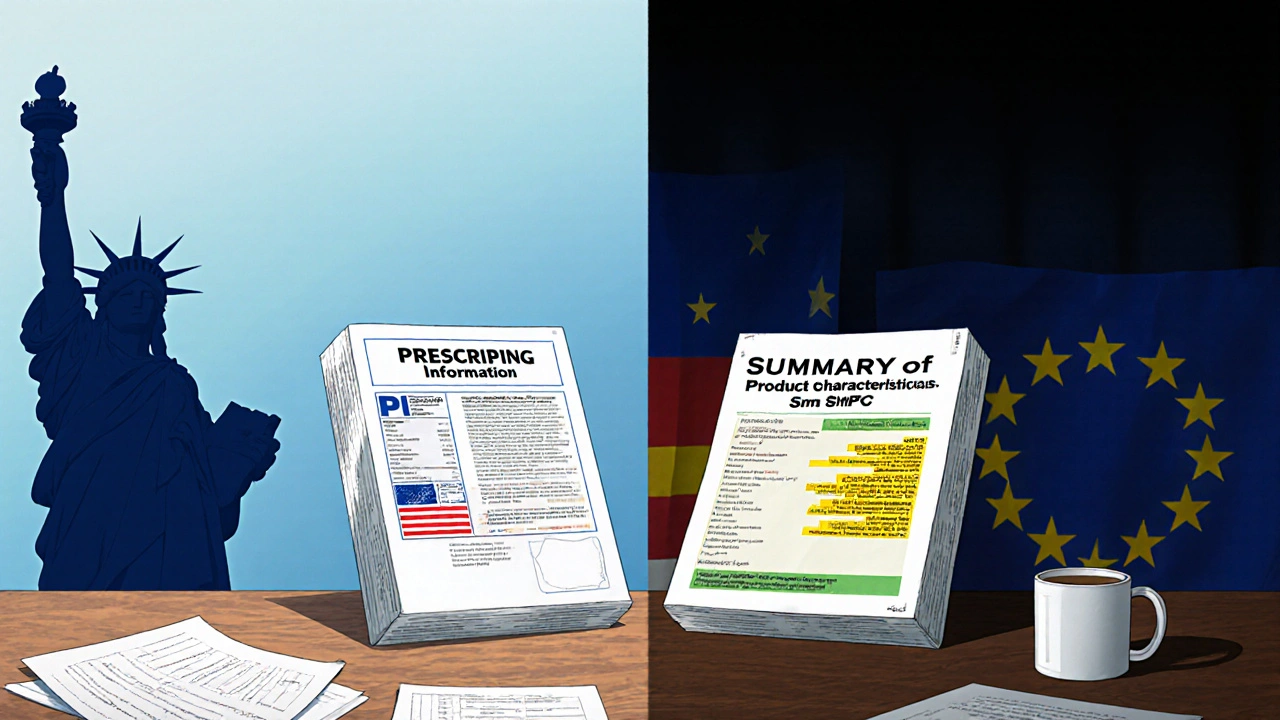EMA vs FDA Labeling Cost Calculator
Estimate the additional costs for preparing dual labeling for EMA and FDA markets based on your product development spend.
Imagine you’ve just gotten a new drug approved in the United States, only to discover that the label you must ship to Europe looks completely different. That’s not a rare headache - it’s a daily reality for multinational pharma teams. The EMA vs FDA drug labeling split creates extra work, extra cost, and sometimes even delays market access.
Legal foundations that shape the labels
Both agencies sit on solid legal ground, but the statutes they follow send them in opposite directions.
European Medicines Agency (EMA) operates under Regulation (EC) No 726/2004, which gives each EU member state a national competent authority that jointly reviews a single dossier. The result is a “decentralized” system where the final product - the Summary of Product Characteristics (SmPC) - must satisfy a Europe‑wide legal text.
U.S. Food and Drug Administration (FDA) is governed by the Federal Food, Drug, and Cosmetic Act, amended by the FDA Amendments Act of 2007. It’s a single, centralized agency that issues the Prescribing Information (PI) - a document that lives entirely within U.S. law.
The two legal frameworks explain why the same clinical data can lead to two very distinct labeling outcomes.
Core labeling documents: SmPC vs PI
The EMA’s SmPC is a structured, paragraph‑by‑paragraph description of the medicine, its therapeutic indications, dosage, contraindications, and safety data. It must be translated into all 24 official EU languages before it can be published.
The FDA’s PI follows a similar outline but is only ever produced in English. The FDA also publishes a separate Medication Guide for certain high‑risk products and a Patient Package Insert for over‑the‑counter drugs.
Because the FDA does not require multilingual versions, companies often spend 15‑20 % less on labeling for a U.S.‑only launch.
Indication scope and evidence interpretation
Studies repeatedly show that the biggest divergence lies in the approved indications. Kashoki et al. (2019) examined 21 paired approvals and found that 52 % of the differences stemmed from each agency’s independent assessment of the same trial data. The EMA tends to accept surrogate endpoints more readily, especially for rare diseases, while the FDA holds a tighter standard for efficacy.
For oncology drugs, this gap widens dramatically: the EMA will sometimes grant a label based on early‑phase data under “exceptional circumstances,” whereas the FDA waits for a confirmatory Phase III trial.
Patient‑reported outcome (PRO) claims
PRO claims illustrate another contrast. An RTI Health Solutions review (2011) of 75 dual‑approved products found that the EMA granted at least one PRO claim for 47 % of them, while the FDA did so for only 19 %.
When both agencies agreed, the claim type was usually a symptom‑relief statement. Functional or patient‑global‑rating claims were far less common in the FDA PI.

Risk management: REMS vs RMP
The FDA’s Risk Evaluation and Mitigation Strategies (REMS) are prescriptive. They can require special certification for prescribers, restricted distribution chains, or mandatory patient education programs. Failure to comply can lead to product withdrawal.
The EMA’s Risk Management Plans (RMP) are more principles‑based. They outline safety concerns, pharmacovigilance activities, and post‑marketing studies, but they rarely dictate exact implementation steps.
Because REMS often need a dedicated IT system and training, companies report an additional 8‑10 % cost increase for a U.S. submission that includes a REMS.
Language and electronic submission requirements
Both agencies demand the eCTD (electronic Common Technical Document) format, yet their regional specifications differ. The EMA’s eCTD must accommodate a multilingual module, a logistical challenge that can add three months to the dossier preparation timeline.
In contrast, the FDA’s eCTD accepts a single English module, making the upload process smoother.
Therapeutic area spotlights
Pregnancy and lactation labeling - The FDA generally adopts a more cautious stance, often using the “risk cannot be ruled out” language unless solid human data exist. The EMA frequently sticks with a standard statement that the drug should be used only if the benefit outweighs the risk.
Vaccines - Seo et al. (2020) compared 12 vaccines approved by both agencies and found almost no consistent alignment in labeling elements, confirming that even for a highly regulated product class, harmonization remains elusive.
Orphan drugs - The EMA’s “exceptional circumstances” pathway can approve a product with limited evidence, a route the FDA does not mirror. Companies must therefore plan separate evidence packages for each region.
Practical impact on pharmaceutical companies
Preparing a dual submission is not just a paperwork exercise; it’s a strategic decision. LS Academy (2023) documented that dual filings require roughly 30 % more documentation effort than a single‑region submission.
Cost estimates vary, but Mabion (2023) put the extra expense of translating and maintaining multilingual labels at 15‑20 % of total development spend.
Because of these pressures, about 65 % of large pharma now employ dedicated regulatory intelligence teams whose sole job is to track labeling divergences and advise on data‑generation strategies that satisfy both agencies.

Emerging harmonization efforts
The International Council for Harmonisation (ICH) has launched the E17 guideline for multi‑regional clinical trials, aiming to produce data that both the EMA and FDA can accept without re‑analysis. Early adoption shows promise, but the guideline’s uptake is uneven across therapeutic areas.
Recent policy moves - the FDA’s 2022 final labeling guidance and EMA’s 2021 Good Pharmacovigilance Practices update - are moving in parallel, not together. Confidentiality Commitment Agreements renewed in 2020 have improved data sharing, yet independent scientific assessments still generate different label wording.
Artificial‑intelligence tools for pharmacovigilance are being piloted at both agencies. If they can standardize signal detection, the downstream label updates may become more synchronized.
Bottom line for stakeholders
Understanding the EMA vs FDA labeling divide is no longer optional for any company that wants to launch globally. The key take‑aways are:
- Legal frameworks dictate central differences - decentralized EU vs centralized U.S.
- Core documents (SmPC vs PI) differ in language requirements and update cycles.
- Evidence interpretation, especially for rare diseases and oncology, often leads to divergent indications.
- Risk management tools (REMS vs RMP) have different implementation burdens.
- Multilingual translation adds significant time and cost.
- Strategic planning and dedicated regulatory intelligence are essential to mitigate delays.
By mapping these gaps early, companies can design clinical programs that collect the right data for both agencies, avoid costly re‑work, and shorten the time to market.
Frequently Asked Questions
How often do EMA and FDA labels align for the same product?
A 2020 study of 12 vaccines found almost no consistent alignment across labeling elements. For most small‑molecule drugs, about 40‑50 % of sections (indications, safety, dosing) match closely, while the rest show regional nuances.
What is the biggest cost driver for dual labeling?
Language translation for the EMA’s SmPC and Patient Information Leaflet is the biggest single expense, accounting for roughly 15‑20 % of total labeling costs.
Can a REMS be avoided by using the EMA pathway?
Not directly. The EMA’s RMP does not require the same prescriber‑certification steps, but the FDA will still demand a REMS if it deems the risk profile high, regardless of the EMA’s approach.
Is it easier to get a first‑cycle approval in Europe or the U.S.?
Data from 2019 show the EMA approves first‑cycle applications at about 92 % versus the FDA’s 85 %, mainly because the EMA’s flexible evidence standards for rare diseases lead to fewer initial rejections.
Where can I find the latest EMA labeling guidance?
The EMA publishes updates on its official website under the “Guidelines on Good Pharmacovigilance Practices” section. The most recent 2021 revision is the current reference.
Comparison table: EMA vs FDA labeling attributes
| Attribute | EMA (EU) | FDA (U.S.) |
|---|---|---|
| Legal basis | Regulation (EC) No 726/2004 | Federal Food, Drug, and Cosmetic Act (as amended) |
| Label document | Summary of Product Characteristics (SmPC) | Prescribing Information (PI) |
| Language requirement | All 24 EU official languages | English only |
| Risk tool | Risk Management Plan (RMP) | Risk Evaluation and Mitigation Strategy (REMS) |
| PRO claim frequency | ~47 % of dual‑approved products | ~19 % of dual‑approved products |
| First‑cycle approval rate | ~92 % | ~85 % |
| eCTD module | Multilingual annex required | Single English module |


Olivia Harrison
October 25, 2025 AT 12:23Great overview, I especially appreciate the clear breakdown of the legal foundations. It really helps to see why the two agencies end up with such different documents. For anyone juggling a dual launch, those cost percentages are eye‑opening. Thanks for pulling all this together in one place!
Bianca Larasati
November 1, 2025 AT 09:23Wow, this post feels like a backstage pass to the regulatory circus! The drama between EMA and FDA is practically a soap opera, and we all get front‑row seats. Keep the insights coming, they’re pure gold for us trying to stay sane.
Corrine Johnson
November 8, 2025 AT 07:23The intricate tapestry of EMA versus FDA labeling, when examined through a lens of systemic divergence, reveals a plethora of multifaceted considerations, each interwoven with statutory mandates, linguistic obligations, and risk management paradigms; consequently, stakeholders must navigate a labyrinthine path, replete with translation overheads, cultural nuances, and divergent evidentiary thresholds. First, the legal scaffolding-Regulation (EC) No 726/2004 for the EMA versus the FD&C Act for the FDA-creates fundamentally different governance structures, decentralised versus centralised, which reverberates through every subsequent document. Second, the SmPC demands multilingual precision across twenty‑four official EU languages, a requirement that inflates both time and budget, whereas the PI remains monolingual, streamlining the submission pipeline. Third, evidence interpretation diverges markedly; the EMA frequently embraces surrogate endpoints for rare diseases, while the FDA insists on robust Phase III confirmation, leading to dissimilar indication scopes. Fourth, patient‑reported outcomes (PROs) appear in nearly half of EMA‑approved labels but under a fifth of FDA dossiers, underscoring a philosophical difference in valuing patient voice. Fifth, risk mitigation strategies-RMP versus REMS-exhibit a contrast between principle‑based planning and prescriptive enforcement, the latter often necessitating dedicated IT systems and training modules. Sixth, the eCTD format, while common, diverges in execution: the EMA’s multilingual annex adds months to dossier preparation, whereas the FDA’s single‑language module accelerates upload. Seventh, cost analyses consistently flag translation as the single greatest expense, accounting for roughly fifteen to twenty percent of total labeling spend. Eighth, strategic planning must incorporate dedicated regulatory intelligence teams, a practice now adopted by two‑thirds of large pharma to preempt misalignments. Ninth, emerging harmonisation efforts, such as ICH’s E17 guideline, aim to align data packages, yet uptake remains uneven. Tenth, the landscape is further complicated by therapeutic‑specific nuances-pregnancy labeling, vaccine specifications, orphan drug pathways-each presenting unique regulatory puzzles. Eleventh, the practical impact is palpable: dual submissions demand roughly thirty percent more documentation effort than single‑region filings. Twelfth, the interplay of regional policy updates, confidential data‑sharing agreements, and artificial‑intelligence‑driven pharmacovigilance promises future convergence, albeit slowly. Thirteenth, stakeholders must map these gaps early, designing clinical programs that satisfy both agencies, thereby mitigating costly re‑work. Fourteenth, the bottom‑line takeaway is clear: understanding the EMA versus FDA labeling divide is no longer optional, but a strategic imperative for global market access. Fifteenth, by internalising these distinctions, companies can streamline timelines, reduce expenditures, and ultimately deliver therapies to patients worldwide with greater efficiency.
Sarah Keller
November 15, 2025 AT 05:23You nailed the philosophical split-EMA looks to the broader patient population, FDA hones in on stringent efficacy proof. I’d add that the aggressive stance of REMS can actually slow adoption in niche markets. Still, the data you presented make a compelling case for early alignment planning.
Veronica Appleton
November 22, 2025 AT 03:23Thanks for the clear summary! The cost numbers really hit home-translation is a hidden monster. I’ve seen teams underestimate the timeline for multilingual eCTD modules, so this is a good reality check. Happy to see the practical tips laid out so simply.
the sagar
November 29, 2025 AT 01:23What they don’t tell you is that the EMA is just a puppet for EU big pharma lobbyists. The whole “decentralized” myth is a cover for hidden fees. You’ll never know the true cost until they lock you into their system. Stay vigilant.
Grace Silver
December 5, 2025 AT 23:23The philosophical underpinnings are fascinating-why we accept different evidentiary standards across borders. It reminds us that medicine is as much about culture as it is about science. Bridging that gap takes more than just data, it needs dialogue. Looking forward to more posts like this.
Clinton Papenfus
December 12, 2025 AT 21:23Indeed, the cultural context shapes regulatory expectations. The EMA’s approach reflects a collective health perspective, whereas the FDA emphasizes individual safety thresholds. Both aim for patient protection, albeit via distinct pathways.
Zaria Williams
December 19, 2025 AT 19:23i think this post is super helpful but i gotta say the langauge part is like sooo crazy. translating 24 languages aint no joke, lol. u really gotta budget for that extra time. also, those cost %s make me nervous lol.